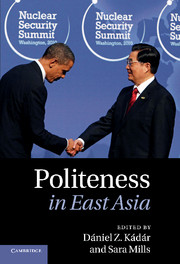Book contents
- Frontmatter
- Contents
- Notes on contributors
- Foreword
- Acknowledgements
- Abbreviations
- 1 Introduction
- Part I Politeness in East Asia: Theory
- Part II Politeness in East Asia: Practice
- 6 Politeness in China
- 7 Politeness in Japan
- 8 Politeness in Korea
- 9 Politeness in Vietnam
- 10 Politeness in Singapore
- 11 Epilogue: Culture and norms in politeness research
- Notes
- Bibliography
- Index
7 - Politeness in Japan
from Part II - Politeness in East Asia: Practice
Published online by Cambridge University Press: 07 September 2011
- Frontmatter
- Contents
- Notes on contributors
- Foreword
- Acknowledgements
- Abbreviations
- 1 Introduction
- Part I Politeness in East Asia: Theory
- Part II Politeness in East Asia: Practice
- 6 Politeness in China
- 7 Politeness in Japan
- 8 Politeness in Korea
- 9 Politeness in Vietnam
- 10 Politeness in Singapore
- 11 Epilogue: Culture and norms in politeness research
- Notes
- Bibliography
- Index
Summary
Introduction
While the study of honorifics in Japan has a long history reaching back hundreds of years, research about politeness in Japanese has only recently emerged over the past thirty years. Much of the work on politeness in Japanese to date has thus inherited a predisposition to explicating politeness primarily in relation to honorifics. There has, however, been increasing attention paid to other forms of politeness as researchers have recognised that a full explanation of (in-)appropriate behaviour in Japanese cannot be limited to the study of honorifics. Work on politeness in Japanese can be traced back largely to the seminal work of Sachiko Ide (1982, 1989, 2005, 2006), who has argued that Japanese politeness is not well served by universal theories of politeness, such as Brown and Levinson's (1978, 1987) face-saving model of politeness, but instead is better explicated with reference to the emic notion of wakimae 弁え ‘discernment’. This debate between culture-specific and universal perspectives on politeness has since come to dominate politeness research on Japanese, and indeed debates about the theorising of politeness in East Asian languages more generally (Haugh and Bargiela-Chiappini, 2010; see also Pan, this volume).
The discursive approach, however, offers an alternative to choosing between such seemingly irreconcilable positions in proposing that the aim of politeness (and impoliteness) research should be for analysts to “focus on the lay interpretation of politeness, by exploring the hearer's evaluation (along with that of the speaker) in longer fragments of discourse, and reach theoretical second-order conclusions by means of analysis of data” (Kádár and Mills, Chapter 1, p. 8). In other words, it is argued that the analysis of politeness should first of all encompass the evaluations of the participants themselves, a first-order perspective which is rooted in, or at least informed by, emic understandings of politeness. However, the aim is not to reify those understandings, but rather to generate theoretical conclusions that are rooted in a second-order, theoretical perspective, namely, that of the analyst. In this way, both culture-specific (emic) and culture-general (etic) perspectives can be respected by politeness researchers.
- Type
- Chapter
- Information
- Politeness in East Asia , pp. 147 - 175Publisher: Cambridge University PressPrint publication year: 2011
- 17
- Cited by



